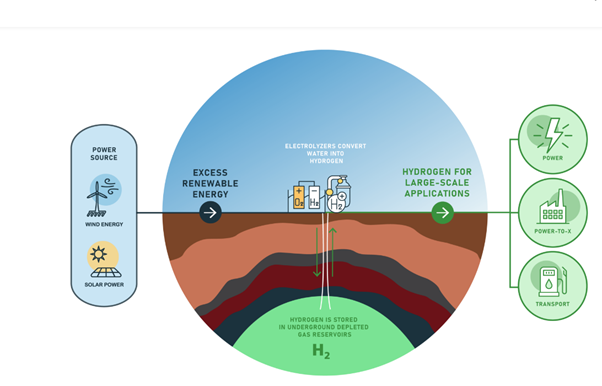Key points
- Abundant renewable energy can be used to make hydrogen, to be stored and then converted back into electricity when it’s needed.
- Organisations in Australia and around the world are exploring whether underground caverns are a safe and cost-effective medium term hydrogen storage method.
- We are researching the feasibility of storing hydrogen in depleted gas fields in Victoria, for Lochard Energy.
Why hydrogen? Hydrogen can be used to firm renewable energy. Firming refers to maintaining the output from an intermittent power source for a required length of time, ensuring energy is always available. In other words: keeping the lights on even when the wind isn’t blowing, and the sun isn’t shining.
When there is an abundance of renewable energy in the grid, this electricity can be put through an electrolyser to make hydrogen. Later, when there is not enough electricity in the grid, the hydrogen can be used to make electricity again.
While a big battery can do this firming work over a period of hours, hydrogen could potentially firm over weeks, months or even seasons. But for seasonal firming, you need to make a lot of hydrogen in the summer to have enough for winter. How can we store all that hydrogen safely and efficiently?
Storing hydrogen underground
Hydrogen can be stored in tanks as a gas under pressure or as a liquid at very cold temperatures. However, for large-scale storage of hydrogen, the cheapest and safest options are found underground. These include salt caverns, depleted gas fields, saline aquifers, or engineered hard-rock caverns.
Salt cavern storage is the most-ready technology. However, depleted gas field storage is the most promising and widely available in Australia and will require less upfront investment. Depleted gas fields are geological formations previously used to extract natural gas. In depleted fields, hydrogen could be stored in the pores of naturally occurring sandstone formations, beneath formations that prevent the movement of gases.
Following on from our research into suitable underground hydrogen storage options in Australia, we took a closer look at a particular location: the Otway Basin in Victoria. Lochard Energy have underground storage sites in existing gas fields which they use to store natural gas. They store it on behalf of their customers during periods of low gas demand. It can then be injected into the pipelines during high gas demand periods such as winter. Lochard Energy was eager to determine if gas fields in the Otway Basin, similar to those they currently use, could also be suitable for hydrogen storage.
In 2023, we teamed up with Lochard Energy to study available data. We wanted to see if there were any technical obstacles for the project before moving forward. This work found no showstoppers. It also produced recommendations for the next stage of scientific study.
Research to convert an idea to a feasible plan
Lochard Energy’s H2RESTORE project is further investigating the opportunity to use their existing gas fields for underground hydrogen storage, to shift low carbon energy seasonally. In March 2024 the Australian Renewable Energy Agency (ARENA) awarded $2 million in Commonwealth Government funding from its Advancing Renewables Program towards Lochard Energy’s 18-month $6.3 million study. This aligns with similar efforts in Europe, where two experimental sites are testing underground hydrogen storage in depleted gas fields.
Our role in this study is to advance the technical analysis of how hydrogen will behave in these subsurface sandstone formations located 1400-1800 metres below the surface. There are four components to the work:
A high-level screening study of the available gas fields
The screening study is a crucial first step to evaluate the key features of six potential storage sites and select one or two sites that show the most promise for a pilot demonstration of underground hydrogen storage.
Static and dynamic modelling of hydrogen storage
In the second step we will build detailed models of the geological structure of the selected sites. We will incorporate the most recent data from seismic surveys and previous sampling of rock properties. The dynamic modelling takes these geological models and uses software to predict how hydrogen will move in the underground formations when it's injected and withdrawn for storage.
Geochemical and microbiological studies of hydrogen interactions
A major question is how stored hydrogen might interact with the rocks, fluids and microbes in the existing gas field, and the cement used for well construction. We will conduct laboratory studies, exposing rock samples from the relevant sites to hydrogen at subsurface temperature and pressure, over a period of weeks to months. We will perform similar tests on samples of wellbore cement, to see if there are any changes due to hydrogen exposure. Matching lab results with theoretical modelling will enable us to make predictions at the field scale.
Geomechanical studies of hydrogen effects on rock properties
The geomechanical studies involve taking rock samples from the storage site and testing their response to stresses before and after exposure to hydrogen. This will show how much the storage of hydrogen might alter the stability of the rock in response to changes in pressure during storage operations.
Firming the renewable power on the National Energy Market (NEM) grid
If Lochard Energy’s investigations we are supporting are successful, they are looking to build a pilot hydrogen production and storage plant. If the pilot demonstrates that hydrogen production and underground storage could be used to firm the NEM, Lochard Energy aim to build a commercial hydrogen plant. The plant could use abundant renewable energy from the grid to produce hydrogen and store it until it’s needed weeks or months later to provide energy back into the grid.

Meanwhile, our research will expand global knowledge of hydrogen storage in geological structures, to potentially decarbonise the energy, transport, and other industries.
